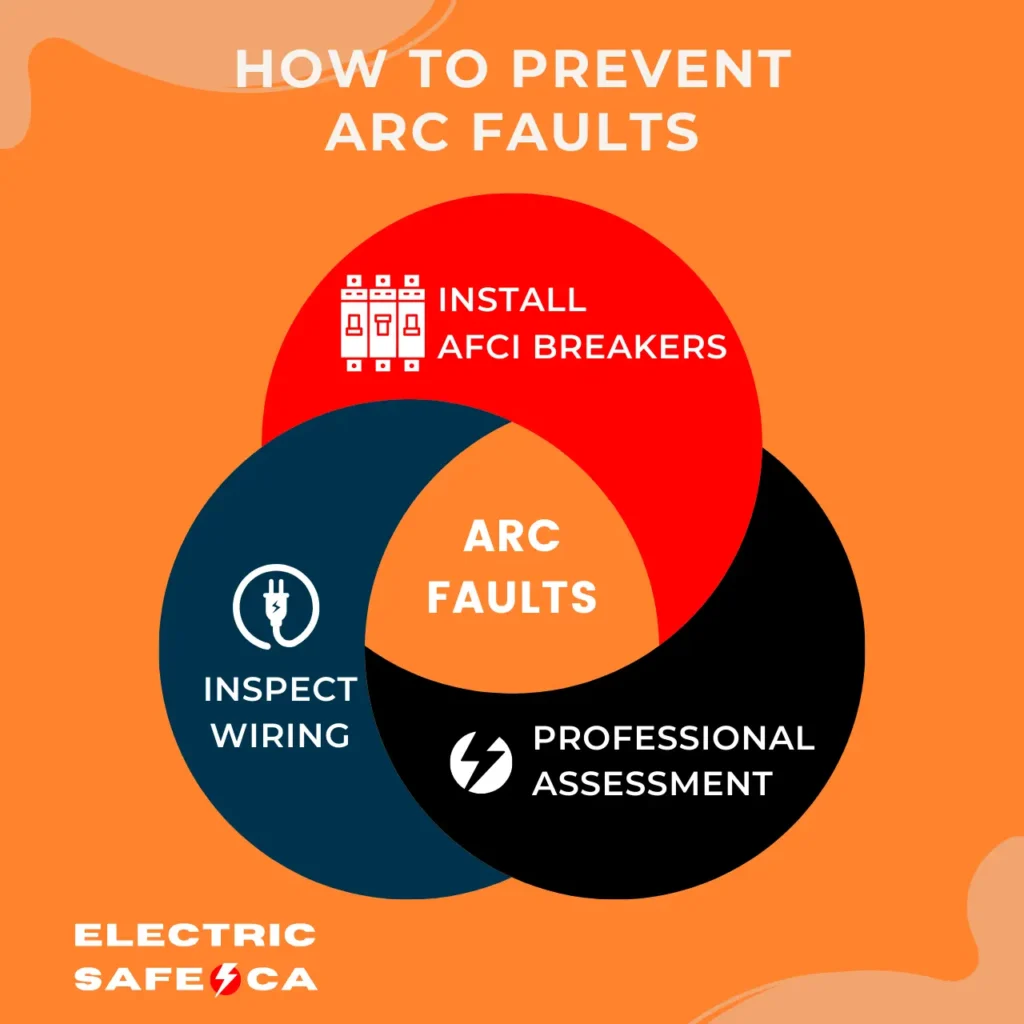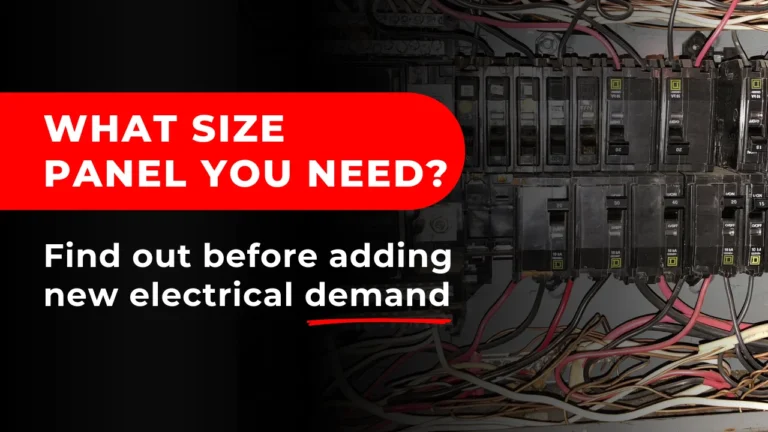You hear a click while you’re watching Netflix on your big screen TV. Suddenly everything goes dark- the TV, the lights in the home, everything. Muttering under your breath, you get up, power on your phone’s flashlight, and head for the basement.
Your home’s circuit breakers serve an important purpose, even when they’re snapping off at the worst times. They instantly cut off the flow of electricity during faults, overloads, and other problems. Without them, any electrical issues could potentially start a fire or even electrocute you when you turn on the lights or plug something in: according to the 2021 Ontario Electrical Safety Report, approximately 20,000 electrical-related emergency department visits occur every year in North America.
For this reason alone, any irregular activity like tripping should be investigated. In this blog, we go over the most common reasons why circuit breakers trip and provide practical tips to prevent and address these issues.
What is a ‘Trip’?
At ElectricSafe, clients often ask us, “Why are my circuit breakers tripping?” Without performing a residential electrical inspection, it’s hard to know the exact cause. However, a breaker generally ‘trips’ because it senses an abnormal power draw and shuts off the electrical flow. By shutting off the circuit, your panel prevents overheating and a potential electrical fire. If you have to reset the breaker frequently, you may have a bigger issue that needs attention.
What Can Cause the Main Circuit Breaker to Trip?
In addition to having breakers for each circuit, the electrical panel also has a main breaker that controls the power to the entire house. While it can trip due to an issue in a specific circuit, this is quite rare. More commonly, why circuit breakers trip due to factors like lightning strikes, surges in the power grid, or if the total electricity usage of your home is higher than the system can handle.
1. Overloaded Circuits
The most common reason for a breaker to trip is an overloaded circuit. This occurs when the demand for electrical power exceeds the circuit’s capacity. When too many devices or appliances draw power simultaneously, the circuit becomes overloaded, causing the breaker to trip to prevent overheating and potential fires. It is the excess heat running through the circuit that causes the breaker to trip.
Solutions to Overloaded Circuits
- Distribute Electrical Loads: Spread out the use of high-power appliances across multiple circuits. For instance, avoid running the microwave, toaster, and coffee maker on the same circuit.
- Upgrade Electrical Panels: If your home has an older electrical panel, consider upgrading it to accommodate increased power demands.
- Use Power Strips Wisely: Avoid overloading power strips with too many devices. Use them only for low-power electronics.
- Unplug Devices: Turn off or unplug devices that are not in use to reduce the load on the circuit.
- Install a New Circuit: Have an electrician add a dedicated circuit for high-draw appliances to make sure they don’t interfere with the rest of your circuits.
If a circuit trips when you turn on the lights or as soon as you plug in or turn on an appliance, it is likely that those actions overloaded it. Unplug some items to lessen the load, and then flip the circuit breaker back on. If the breaker immediately trips again, you may have a more serious issue.
2. Short Circuits
A short circuit occurs when a hot wire (live wire) comes into contact with a neutral wire or another hot wire, creating a low-resistance path for the electric current. This sudden surge of electricity can cause the breaker to trip to protect the circuit from damage and prevent fires.
Common causes of short circuits include:
- Faulty Wiring: Damaged or worn-out wiring can lead to short circuits. Look out for frayed wires or exposed metal.
- Loose Connections: Loose connections at outlets, switches, or junction boxes can cause short circuits.
- Defective Appliances: Malfunctioning appliances with internal wiring issues can cause short circuits when plugged in.
Preventing Short Circuits
- Regular Inspections: Periodically inspect your home’s wiring and replace any damaged or worn-out wires.
- Professional Installation: Make sure all electrical installations are done by a qualified electrician to avoid loose connections.
- Test Appliances: Regularly test and maintain appliances to verify they are in good working condition.
- Look for Signs: Be aware of brown or black discoloration or a burning smell from an outlet, which may indicate a short circuit.
If you suspect a short circuit, the best solution is to contact an electrician. They will inspect, repair, or replace any outlet you suspect may have a short in it. Never leave anything plugged into a shorted outlet until it has been repaired.
3. Ground Fault Surges
A ground fault surge is a specific type of short circuit that occurs when a hot wire touches either the ground wire or a metal electrical box connected to the ground wire. Ground faults can be caused by poorly insulated or damaged wiring inside your walls or in your appliances. They can also result if water gets into your outlet. As with short circuits, a ground fault surge will usually result in a burning smell and discoloration around your outlet.
Ground fault surges can potentially be even more dangerous than short circuits. This is especially true when the ground fault is caused by water, as it can potentially lead to electrocution.
For this reason, all new homes are required to use GFCI (Ground Fault Circuit Interrupter) outlets in basements, garages, bathrooms, outdoor receptacles, and kitchens, as well as for any outlets located within six feet of a water source. These GFCIs provide an extra level of protection and act like a circuit breaker specifically for that outlet. In the event of a ground fault surge, the GFCI will kick in and automatically switch off the power to the outlet.
Preventing Ground Fault Surges
- Install GFCI Outlets: Ground Fault Circuit Interrupter (GFCI) outlets are designed to protect against ground faults. They are especially important in areas where water is present.
- Regular Testing: Test your GFCI outlets monthly by pressing the “test” button to confirm they are functioning correctly.
- Proper Wiring: Ensure that all outlets and switches are properly grounded to prevent accidental contact between hot wires and grounded surfaces.
- Inspect for Damage: Regularly inspect your outlets for signs of damage and unplug all devices from a defective outlet until an electrician can look at it.
4. Arc Faults

Arc faults occur when there is an unintended arc of electricity due to loose or corroded connections, damaged wires, or faulty appliances. These arcs generate intense heat that can ignite surrounding materials, posing a fire hazard. Arc Fault Circuit Interrupters (AFCIs) are designed to detect and interrupt arc faults.
Preventing Arc Faults
- Install AFCI Breakers: Consider installing AFCI breakers in your electrical panel. They can detect and interrupt arc faults before they cause a fire.
- Inspect Wiring: Regularly inspect your home’s wiring for signs of damage, corrosion, or loose connections.
- Professional Assessment: If you suspect an arc fault, have a licensed electrician assess your electrical system and make necessary repairs.
5. Faulty Appliances
Sometimes the problem lies not in the electrical system but in the appliances themselves. Faulty appliances can draw excessive current or cause short circuits, leading to a tripped breaker.
Identifying Faulty Appliances
- Frequent Trips: If your breaker trips frequently after plugging in a specific appliance, that appliance may be faulty.
- Visible Damage: Check for visible signs of damage, such as frayed cords, burnt plugs, or strange noises.
- Professional Inspection: Have a professional inspect and repair or replace faulty appliances.
Preventing Issues with Appliances
- Regular Maintenance: Perform regular maintenance on your appliances to confirm they are in good working condition.
- Avoid Overloading: Do not overload appliances beyond their rated capacity.
- Replace Damaged Appliances: Replace any appliances that show signs of damage or wear.
6. High Inrush Current

High inrush current occurs when certain devices or appliances, such as motors and transformers, draw a large amount of current when they are first turned on. This sudden surge can cause the breaker to trip.
Managing High Inrush Current
- Stagger Start Times: If you have multiple devices with high inrush currents, avoid turning them on at the same time.
- Soft Starters: Consider using soft starters for motors and other heavy-duty appliances to gradually increase the current and reduce the initial surge.
- Dedicated Circuits: Use dedicated circuits for high inrush current devices to isolate them from other circuits.
7. Environmental Factors
Environmental factors such as high temperatures, humidity, and dust can affect the performance of circuit breakers. Excessive heat can cause breakers to trip more easily, while moisture and dust can lead to short circuits and other electrical issues.
Addressing Environmental Factors
- Proper Ventilation: Keep your electrical panel well-ventilated to prevent overheating.
- Moisture Control: Use dehumidifiers in damp areas and ensure proper sealing of outdoor electrical components.
- Regular Cleaning: Keep your electrical panel and outlets clean and free from dust and debris.
8. Age and Wear
Over time, circuit breakers can wear out and become less effective at protecting your electrical system. Older breakers may trip more frequently or fail to trip when needed.
Maintaining Circuit Breakers
- Regular Testing: Test your circuit breakers regularly to see that they are functioning correctly.
- Professional Inspection: Have a licensed electrician inspect your electrical panel periodically and replace any worn-out breakers.
- Upgrade When Necessary: If your home has an outdated electrical panel, consider upgrading to a modern panel with more reliable breakers.
9. Loose Connections
Loose connections in your electrical system can lead to increased resistance, heat buildup, and ultimately, breaker trips. These loose connections can occur at outlets, switches, junction boxes, or within the breaker panel itself.
Preventing Loose Connections
- Tighten Connections: Periodically check and tighten all electrical connections in your home.
- Professional Help: If you are unsure about tightening connections yourself, hire a qualified electrician to do it for you.
- Avoid DIY Repairs: Avoid making electrical repairs yourself if you are not experienced, as this can lead to loose connections and other hazards.
10. Incorrect Breaker Rating
Using a breaker with an incorrect rating for the circuit it protects can lead to frequent trips. A breaker that is too small will trip easily, while one that is too large may not trip when it should, posing a safety risk.
Ensuring Correct Breaker Rating
- Consult an Electrician: Have a licensed electrician determine the correct breaker size for your circuits.
- Label Circuits: Clearly label your electrical panel to ensure that each breaker matches the circuit it protects.
- Avoid Oversizing: Never replace a tripping breaker with one of a higher rating without consulting a professional, as this can lead to serious safety issues.
11. Old or Faulty Circuit Breakers
In some cases, your circuit breakers might be tripping due to a problem with the breaker itself. If your breaker or your electrical panel is old, faulty, or not wired properly, it can also cause the breakers to trip. Although this is generally quite rare, it is important to consider if other solutions have not resolved the issue.
It’s important to understand why a circuit breaker has tripped before resetting it. Ignoring the underlying problem and simply resetting the breaker can result in hazardous conditions like fires and even injuries. At ElectricSafe, we don’t recommend resetting any breakers without understanding why the circuit breaker tripped and shut off power in the first place. Always consult a licensed electrician for any concerns or advanced issues related to your home’s electrical system.
Tripping Circuit Breakers? Help is Available!
Understanding the common reasons why circuit breakers trip can help you maintain a safe and efficient electrical system in your home. By taking preventive measures and seeking professional assistance when needed, you can reduce the risk of breaker trips. Always prioritize safety and consult a licensed electrical contractor for any concerns or complications related to your home’s electrical system.
If you need reliable and expert electrical services in Hamilton, ON, turn to ElectricSafe. Our experienced team will help you understand your electrical system and implement any necessary upgrades to support proper functionality. Don’t let minor electrical issues escalate into major ones—contact ElectricSafe today for a free estimate and experience peace of mind.




